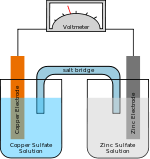Potassium-ion battery
A potassium-ion battery is a type of battery and analogue to lithium-ion batteries, using potassium ions for charge transfer instead of lithium ions, which was first introduced by the Iranian/American chemist, Ali Eftekhari (President of the American Nano Society), based on a potassium compound Prussian blue as the cathode material.[1] The reason for this selection was high electrochemical stability of Prussian blue,[2] and thus the prototype of the battery was successfully used for millions of cycles.
The potassium battery has certain advantages in comparison with similar lithium batteries (e.g., lithium-ion batteries): the cell design is simple, and both the material used and the procedure needed for the cell fabrication are cheaper. The prototype was made of KBF
4 electrolyte though almost all common electrolyte salts of lithium batteries (their potassium salts) can be used for the construction of potassium battery. The chemical diffusion coefficient of K+
in the cell is higher than that of Li+
in lithium batteries, which is due to a smaller Stokes radius of K+
in electrolyte solution (solvated ions). Since the electrochemical potential of K+
is identical to that of Li+
, the cell potential is similar to that of lithium-ion. Potassium batteries can accept a wide range of cathode materials with excellent rechargeability, cheaper materials, etc. A noticeable advantage of potassium battery is the availability of potassium graphite, which is used as an anode material in current lithium-ion battery. Its stable structure guarantees a reversible intercalation/de-intercalation of potassium ions during the charging/discharging process.
In 2005, a potassium battery that uses molten electrolyte of KPF
6 was patented.[3][4] In 2007, a Chinese company Starsway Electronics marketed the first potassium battery-powered portable media player as a high-energy device.[5]
It is believed that potassium battery can replace lithium battery for large-scale energy storage because of its exceptional cycleability, as reported by the researchers of Northwestern University in Nature Communications.,[6][7]
Low cost of potassium in comparison with lithium has highlighted the idea of potassium battery in other forms too. Researchers at Ohio State University (OSU) have demonstrated the concept of a potassium-air (K−O2) battery with low overpotentials.[8]
See also
- Lithium-ion battery
- Lithium–air battery
- Thin-film battery
- Rechargeable electricity storage system
References
- ↑ Eftekhari, A (2004). "Potassium secondary cell based on Prussian blue cathode". Journal of Power Sources 126: 221. doi:10.1016/j.jpowsour.2003.08.007.
- ↑ Itaya, K; Ataka, T; Toshima, S (1982). "Spectroelectrochemistry and electrochemical preparation method of Prussian Blue modified electrodes". Journal of the American Chemical Society 104 (18): 4767. doi:10.1021/ja00382a006.
- ↑ US 20090263717 Ramasubramanian, M; Spotnitz, RM
- ↑ US 2005017219 Li, W; Kohoma, K; Armand, M; Perron, G
- ↑ Melanson, D (24 October 2007). "China's Starsway touts potassium battery-powered PMP". Engadget. Retrieved 2011-09-16.
- ↑ "New Battery Technology Could Provide Large-Scale Energy Storage for the Grid". 25 November 2011.
- ↑ "Battery electrode's 40,000 charge cycles look promising for grid storage". 22 November 2011.
- ↑ "OSU team demonstrates concept of potassium-air battery as alternative to lithium-air systems". 18 February 2013.
